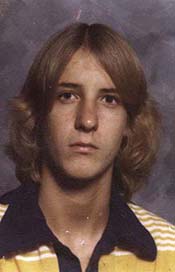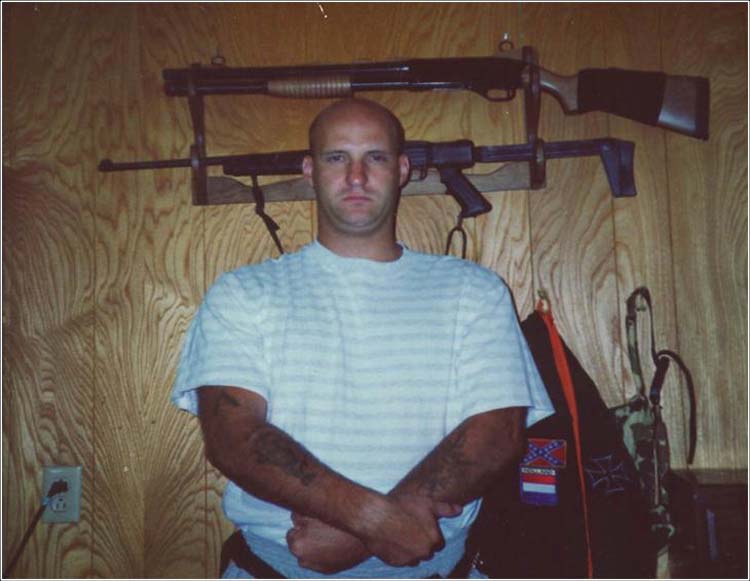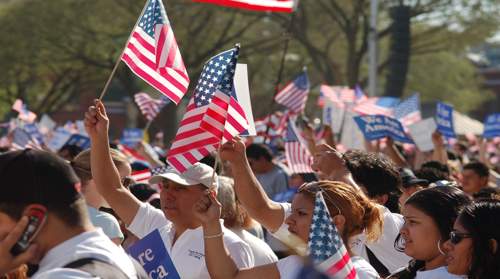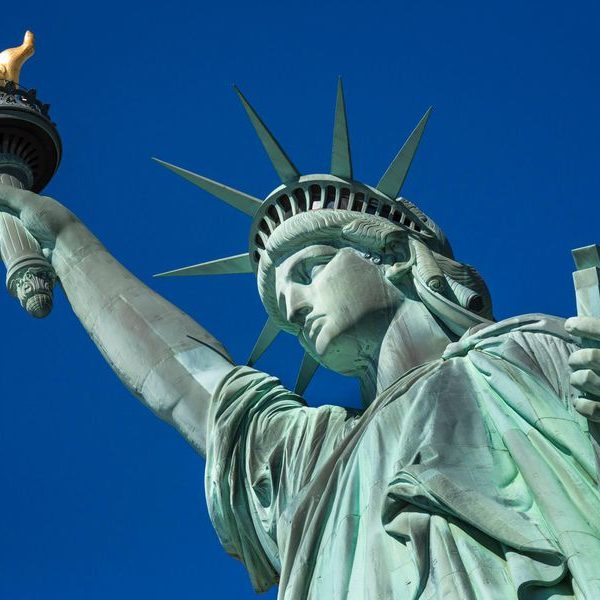Above: Tim Zaal (left) and Matthew Boger met as volunteers with the Los Angeles Museum of Tolerance. Zaal, a one-time neo-Nazi, attacked Boger as a teen. The two are now close friends. (Image credit: BuzzFeed News).
LOS ANGELES — Can hate be healed? The question has been central to Tim Zaal’s life.
When Zaal was 17, he and his friends went looking for a night-time brawl in West Hollywood. Near a crowded hangout called Oki Dogs on Santa Monica Boulevard, they spotted a group of young people and yelled, “Let’s go kill the faggots!” They chased one gay, homeless boy, 14, into an alley and beat him. As he lay on the ground, Zaal kicked him in the forehead with a razor-studded boot, knocking him unconscious.
Zaal had been a Nazi punk in his teens, but by his mid-twenties, he had become a fervent racist skinhead. He and three other skinheads attacked an Iranian couple with a small child that they had come across in a supermarket parking lot. The crime made headlines in Southern California and put him in jail, but also made him notorious in white supremacist circles.
Zaal, a powerfully built man who sports a goatee and tattoos, is now 53. Two decades ago, he renounced organized hate groups and has since reinvented himself as a spokesperson for tolerance. Visitors listen spellbound as he talks about turning his back on bigotry at Los Angeles’s Museum of Tolerance, which explores racism and prejudice, including the events of the Holocaust.
The museum has changed his life in startling ways. When Zaal met Matthew Boger, a manager at the museum, the two men swapped life stories. Boger’s mother had cast him out of their Northern California home after he told her he was gay. As a young teen, he made his way to L.A. and survived through prostitution. He scrambled his way off the streets and built a successful career as a hair colorist before joining the museum staff.

Above: Tim Zaal at 15 (Image courtesy of the Simon Wiesenthal Center)
As the men talked about hanging out near Oki Dogs in their youth, they slowly realized that their paths had crossed before. Boger, now 50, was the gay teen that Zaal had brutalized decades ago. Zaal still remembered the somber drive back to his suburban home in the East San Gabriel Valley so long ago, wondering if he had killed the boy. At last he knew the answer.
For Boger, raw anger resurfaced. After a protracted and painful reckoning, including an apology from Zaal, the pair grew into close friends – like family, according to Boger. When his partner died of cancer, Zaal was the first one there for him. Boger has said publicly, “I trust him with my life.”
“I’m a changed person,” says Zaal, who married a Jewish woman. But he still struggles with the shame and guilt of having harmed innocent people during a youth spent raging against Jews, non-whites and gay people. During one museum talk, a visitor asked, “Matthew has forgiven you. God has forgiven you. But have you forgiven yourself?”
It’s a continual process, Zaal says. “It depends on the day, how I feel about forgiving myself.”
No uniform approach to treating hatred
How to heal those who hate has been a crucial question throughout psychologist Edward Dunbar’s career. Dunbar, a clinical professor of psychology, has studied hate crimes in Los Angeles and written extensively about hate groups and violence. He also has counseled hate crime offenders.
“If you think of how we respond societally to hate crimes, we essentially punish the offender. We may make some effort at helping the victim, but we have worked up a pretty conventional criminal justice approach, which means probation and incarceration,” he says.
The mental health community knows little about treating hatred, racism and extremism, according to Dunbar. “We’re not sure what to do or how to do something with these individuals. We don’t have a uniform approach.”
And yet, the stakes are high, he says. “Hate crime’s not just like any other crime. It’s a crime against an entire group of people.”
For years, Dunbar has adapted his own methods for counseling hate crime offenders, including evaluating them for mental illness, exploring the factors that led them to commit a hate crime, and helping them to make practical plans to redirect their lives away from racism and violence. Besides counseling, some may need psychiatric treatment or help with drug or alcohol abuse, he says.
Christian Picciolini, director of ExitUSA, a nonprofit program that supports men and women who leave hate groups, agrees with Dunbar. “The mental health community is in serious need of training,” says Picciolini, who spent eight years within a neo-Nazi group in Chicago. “So many of the cases I’m involved with are driven by a mental health condition,” he says, like depression and schizophrenia.
Most of ExitUSA’s clients have been involved with white supremacy. When they graduate from the program’s interventions, they enter ExitUSA’s network of “formers,” those who have left hate groups and now support each other and serve as mentors, Picciolini says. About 100 formers are now connected through ExitUSA. Tim Zaal is one of them.
In an ideal situation, Zaal says, hate crime offenders would be rehabilitated through the law enforcement and mental health fields, as well as with the guidance of formers.
He mentors “three former skinheads,” two in California and one back east. “All are in contact with me on a regular basis. It’s integral that they have somebody to identify with, who knows the language, knows the mindset,” Zaal says.
“It’s like a former cult member trying to help a cult member get out of a cult.”
What motivates hate crime offenders?
When Zaal became a Nazi punk in the 1980s, he existed on the fringes — “the safety pins in the cheeks, the dog collars, the razors in the boots,” he says. Now, members of the far right try to look mainstream, he says. They’re instructed to “join the military, grow your hair out, don’t get tattoos, don’t get in trouble with the law, keep your head down, basically.”
But while they may look different, experts say the underlying motivations remain the same. “They’re looking for a sense of identity and purpose and a community,” Picciolini notes. “The ideology is secondary.”
In his research, Dunbar has found a U-shaped age curve among hate crime offenders, with minors and hardened racists over age 35 being the largest groups.
When he counsels offenders, he says, “We’re trying to sort out the difference between people who are bonding with a criminal group and if (that group) is a hate group because (the individual) has no alternatives; versus people who may be more psychologically disturbed; versus people who may simply be more prone to a lifelong criminal lifestyle.”
He adds that many of the offenders he works with come from a troubled home environment. Some haven’t graduated from high school and lack hope for the future. “The bias may not be the primary problem,” Dunbar says. “It may frankly be the third, fourth or fifth problem.”
“They’re kids that are distressed, kids that are lost,” he says. “This even applies to some of the neo-Nazi gangs. The primary issue in these individuals is not really the bias. The primary issue is that they have a sense of membership with a group of people who are inclined toward the violent, anti-social lifestyle. It’s a place to bond and connect.”
“If we can give them something else that’s plausible to bond and connect around, the bias may suddenly not matter anymore to them.”
That’s especially true for teens.
“The kids I’ve known where I’ve seen them revert out of these hate groups, it’s because they’ve developed an alternative ideology. It sounds simplistic, but it’s hugely important,” he says. “Can you develop a romantic relationship with somebody who’s not in a hate group? Can you get a job? Can you have some coherent sense of the future? Those become competing ideologies to feeling like you’re alienated, you’re a loser, and you find the overarching ‘myth culture’ that it’s because of people who are different that your life is so terrible.”
Getting Out
In Zaal’s case, a jail sentence didn’t deter him. Upon release, he went straight back to organized hate groups. “Nobody recruited me. I wanted to get involved,” he says. White supremacy leaders wooed him with acceptance and flattery. They told him that he had leadership abilities. They put him in charge of neo-Nazi recruitment and propaganda efforts in Los Angeles.
He existed in a bubble of white supremacy. “Everything was ‘the enemy, the enemy.’ A lot of people involved with the far right – it was that mindset. ‘We’re going to have a race war. We have to be ready, we have to stockpile,’ this kind of thing. We were expending a lot of time, energy and money. Again, it’s cult-like.”

He became involved with a woman who was also heavily involved in the skinhead movement and they had a son. “We raised our son in that environment,” Zaal says. The couple gave him high-fives and cookies as rewards for using racial epithets.
But as with many former racists, starting a family forced a reality check for Zaal. “Parenthood played a major role in the disengagement process. Not for all of us, but many of us,” he says.
He recalled a day when he took his son, then two years old, into their neighborhood grocery store. An African American man walked by. “Just a little kid sitting in a shopping cart like any other kid and he pointed and said, ‘Look, Daddy, there’s a big black n…”
The man shook his head in disgust and walked away, Zaal recalls. “But it was the ladies shopping in the same aisle that really gave it to me. They gave me the blow-dryer: ‘How dare you? How could you teach an innocent child such hateful words?’”
Instead of praising his son, Zaal says, “I kind of had a taste of shame. I kind of put my head down.”
The moment changed him. He realized that on this path, his son would have no future.
He also began traveling for construction jobs, sometimes in Texas, and worked side by side with Latinos and African Americans. They were kind to him, which was key, he says. “If this African American person, this Hispanic person, is treating me with respect, they can’t all be bad. They can’t all want to kill me.”
The encounters threw him into confusion and crisis. “I would go back home into that delusional bubble.” In time he could no longer reconcile the insular world of white supremacy with the life beyond. “I had to get out.”
In 1996, he walked away from the movement and broke up with his son’s mother, who remained in the group.
The hatred and violence that had once fueled him like a drug no longer worked, he says. While some leave and lose their sense of identity, that wasn’t the case for Zaal. “More than anything, I was relieved,” he says. “By the time you’re in your late twenties and you’ve been living your adolescent years and part of your young adulthood in this chaotic, stressful, controlling environment and spending all your energy – it takes so much energy to hate like that.”
“I put myself into situations for so many years—’This is a black person, this is a brown person, I don’t trust them, I’m not going to touch them,’ that sort of thing. You just want relief – any way to get relief.”
After years of trying to avoid people of color, “I had to learn to be comfortable with non-white people,” Zaal says.
His new life took unanticipated turns. After splitting up with his son’s mother, he went on a double date with a woman from Texas. “She had a Southern twang, red hair, freckles, very petite. That was my style,” he says.
She knew of his background from friends, but he knew less about hers. “Everything worked out great and when I walked her to the porch, she looked at me and said, “I hope you know I’m Jewish. You got a problem with that?”
“It totally blew my preconceptions out the window. But you get to know a person for being a person first, not just a label,” he says. The two remain married to this day.
Filling potholes
What Zaal learned to do on the job and in his love life, Picciolini coaches through ExitUSA. About 70 percent of those who get in touch with ExitUSA are men and 30 percent are women, he says. They range from age 15 to people in their fifties.
He makes it a point not to argue with those emerging from hate groups. Instead, he looks for what’s lacking in their lives.
“I’m not challenging their ideology. I’m not telling them that they’re wrong or stupid because that’s just going to polarize us,” he says. “I do a lot of listening and I listen for those potholes – whatever is missing. Then I fill in those potholes by helping them find job training or tattoo removal or mental health therapy.”
Once their lives improve, the ideology can fall away, he says.
Most people that Picciolini has worked with “have never met or had a meaningful interaction with somebody that they think that they hate,” he says.
“How to challenge their narrative and the ideology and doctrine is I actually do what I call immersion. I introduce them to people that they think that they hate,” he says.
“My whole goal is to humanize people. I put them in a situation that challenges their narrative without having a debate about their ideology. I want them to feel it because I know that it’s hard to deny kindness.”
“Once they’re completely disengaged, we graduate them to the formers network where they can get community care,” he says, including mentorship and life coaching.
Dunbar agrees that it’s easier to tackle the psychosocial issues before the bias itself. “It may mean trying to get you a job. We may get you out of an alcoholic home or out of the criminological network,” he says.
In some, the bias may remain. “This runs through the whole idea of rehabilitation,” Dunbar says. “We are really talking about changing behavior. At the end of the day, if a person holds racial animus, but they learn that there are reasons not to go out and engage in hostile, violent actions, our culture says that we tolerate that. A person may still be fearful of exposure to people who don’t speak English, but they now don’t go out and damage their car.”
Giving back
Compassion and empathy are key to change, Picciolini says. “The underlying theme that I’ve heard over and over again is that we received compassion from the people that we least deserved it from.”
“That’s another very common aspect for many of us formers,” Zaal says. “We’re respected and not judged by the people whom we’ve perceived as the enemy. A lot of us, when we get out, we get educated and get our lives together and we start to give back.”
He warns young people who are tempted to flirt with hate groups, now made easier through the internet and social media: “Don’t be a puppet, because at the end, they’ll chew you up and spit you out. They’ll manipulate you. Some are slicker than others, but at the end of the day, they’re out for themselves.”
It’s emotionally grueling to keep talking about his past, he says. According to Zaal, guilt and shame commonly trigger thoughts of self-harm and suicide among former members of the far right.
At one point, he grappled with whether to keep speaking at the museum. But he decided to continue as a form of therapy, an atonement. He feels a sense of purpose, he says, when he looks into the faces of the students in the audience. “It is therapeutic when I see the light come on. It’s worth it.”
This story was produced through a partnership with New America Media and ProPublica’s Documenting Hate Project. To report a hate crime, use this form. Reports will be verified before entering a national database that will be made available, with privacy restrictions, to newsrooms and civil rights organizations across the country. The form is not a report to law enforcement or any government agency.










